Everyone knows the cashew nut that delights our appetizers and pastries, but few know what the plant that produces it looks like; it is so amazing that the Lao people call it muang himapharn: “mango of paradise”. Its name, in French and in English, is “a travel term”, introduced into the language by missionaries, botanists and adventurers of all kinds, who traveled the world from the 16th century and brought back rare and exotic products. In this case, the word “cashew” is taken from the Amerindian tupi language of Brazil, where this plant is native; however, there is an etymological confusion, the word designating both a fruit and a tree, cashew and mahogany.
The cashew tree is not very remarkable, of medium size, its trunk is short, its leaves obovate, 10-20 cm long, its flowers small and white. Its “fruit” is fleshy in the shape of a small pear of a pretty color ranging from red to orange-yellow, called cashew apple; it is prolonged by the “nut” in the shape of a kidney. Botanically speaking it is this nut which is the fruit, its support being only a hypertrophied peduncle, a false fruit.
The cashew apple tree, which prefers dry and sandy soils, is grown in all tropical countries; in the Indochinese peninsula, it grows especially in Cambodia and in the south of Vietnam and Thailand.
Cashew apples are not found in markets in temperate countries because they do not keep well once picked. In Laos, as often, it is eaten with salt and pepper. Elsewhere it is eaten ripe and its more or less tangy taste is very refreshing, it is also particularly rich in vitamin C; it is also made into juices and jams.
Undoubtedly it is the nut that has the most uses. When the apple is withered or has been eaten, there remains the nut which is brought to the fire to eliminate the caustic principle contained in the envelope, it can then be broken and the kernel tasted after having stripped of its thin skin.
By pressure, an oil is extracted from the almond which has characteristics very similar to those of the sweet or bitter almond; it is used in food and in pharmacy.
From the incised bark of the cashew apple tree flows a sap used for the preparation of indelible ink and to dye fabrics black. The oldest trees give a gum which can make a good varnish for wood and which also has insecticidal properties.
The irritating liquid extracted from the fruit envelope, “cashew balm”, is used externally against warts, corns, cracks on the sole of the foot and formerly leprosy; internally it is a good vermifuge. The Institute of Traditional Medicine also recommends leaf decoctions to fight diabetes.
Tout le monde connaît la noix de cajou qui fait les délices de nos apéritifs et de nos pâtisseries, mais peu savent à quoi ressemble la plante qui la produit; elle est si étonnante que les Lao la nomment muang himapharn: « mangue du paradis ». Son nom, en français et en anglais, est « un terme de voyage », introduit dans la langue par les missionnaires, botanistes et aventuriers de toutes espèces, qui parcourent le monde à partir du XVIème siècle et en rapportent produits rares et exotiques. En l’occurrence le mot « cajou » est pris à la langue amérindienne tupi du Brésil, d’où est native cette plant; il y a cependant une confusion étymologique, le mot désignant à la fois un fruit et un arbre, le cajou et l’acajou.
L’arbre à cajou n’est pas très remarquable, de taille moyenne, son tronc est court, ses feuilles obovales, longues de 10- 20 cm, ses fleurs petites et blanches. Son « fruit » est charnu en forme de petite poire d’une jolie couleur allant du rouge au jaune orangé, appelé pomme de cajou; il est prolongé par la « noix » en forme de rein. Botaniquement parlant c’est cette noix qui est le fruit, son support n’étant qu’un pédoncule hypertrophié, un faux fruit.
Le pommier cajou qui préfère les terrains secs et sableux, est cultivé dans tous les pays tropicaux; dans la péninsule indochinoise, il pousse surtout au Cambodge et au sud du Vietnam et de la Thaïlande.
On ne trouve pas de pomme cajou sur les marchés des pays tempérés car elle se conserve très mal une fois cueillie. Au Laos, comme souvent, elle est mangée avec du sel et du piment. Ailleurs on la mange mûre et son goût plus ou moins acidulé est très rafraîchissant, elle est d’ailleurs particulièrement riche en vitamine C; on en fait aussi des jus et des confitures.
Mais c’est sans conteste la noix qui a le plus d’utilisations. Lorsque la pomme est flétrie ou qu’elle a été mangée il reste donc la noix que l’on porte au feu pour éliminer le principe caustique contenu dans l’enveloppe, on peut alors la casser et en déguster l’amande après l’avoir débarrassée de sa fine peau.
Par pression on extrait de l’amande une huile qui a des caractéristiques très voisines de celles de l’amande douce ou amère; on l’utilise dans l’alimentation et en pharmacie.
De l’écorce incisée du pommier cajou s’écoule une sève utilisée pour la préparation d’encre indélébile et pour teindre les tissus en noir. Les arbres les plus vieux donnent une gomme qui peut faire un bon vernis pour le bois et qui a en outre des propriétés insecticides.
Le liquide irritant extrait de l’enveloppe de fruit, « le baume de cajou », est utilisé, en usage externe, contre les verrues, les cors, les crevasses de la plante du pied et autrefois la lèpre; en usage interne c’est un bon vermifuge. L’Institut de médecine traditionnelle préconise également des décoctions de feuilles pour lutter contre le diabète.
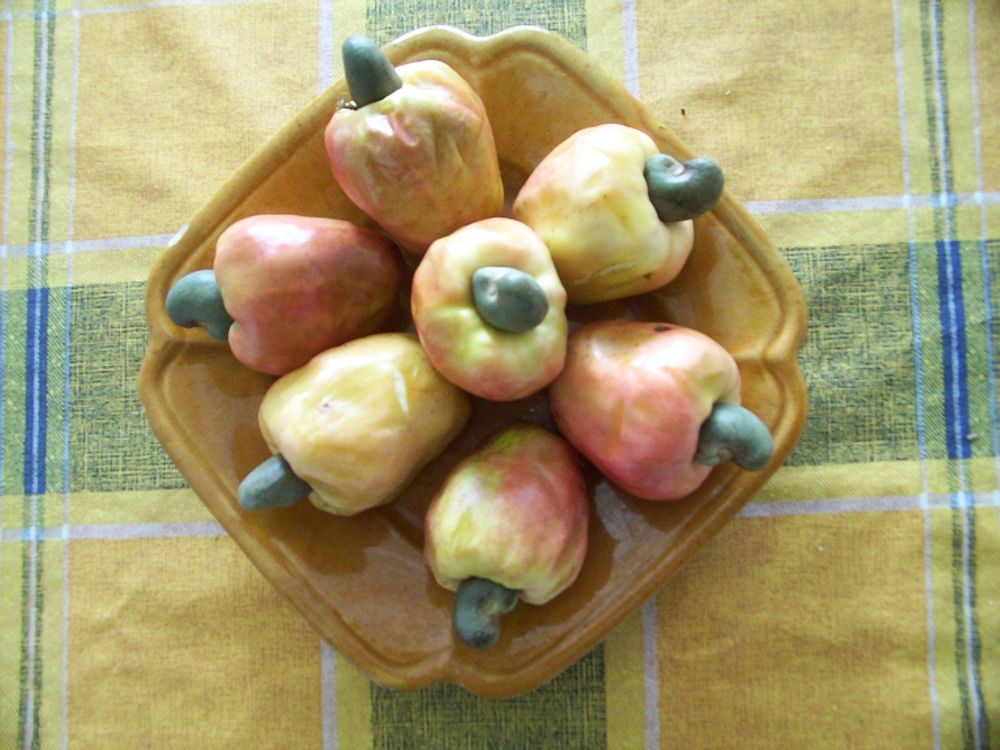
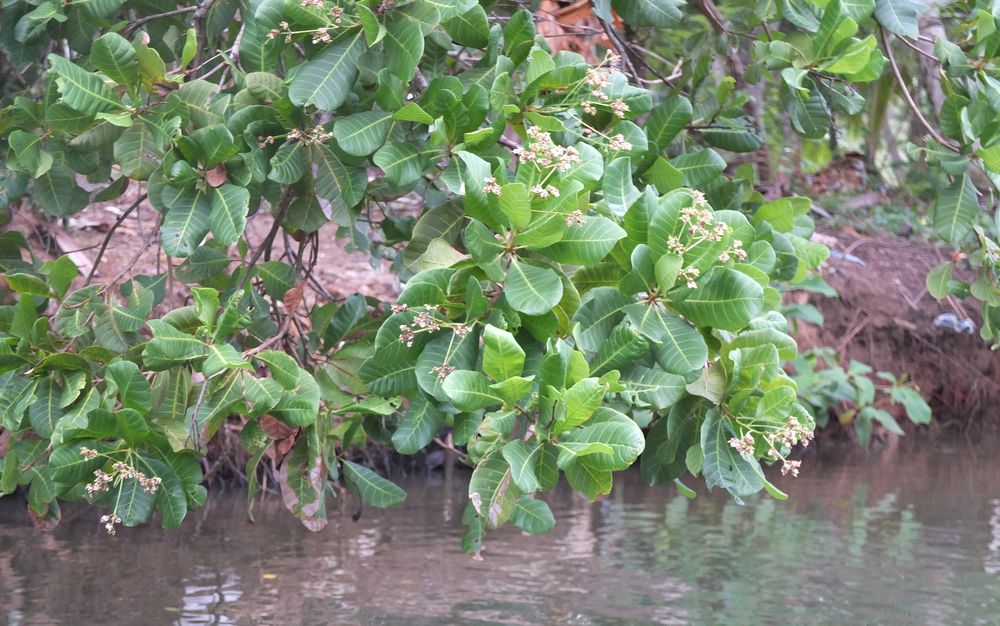
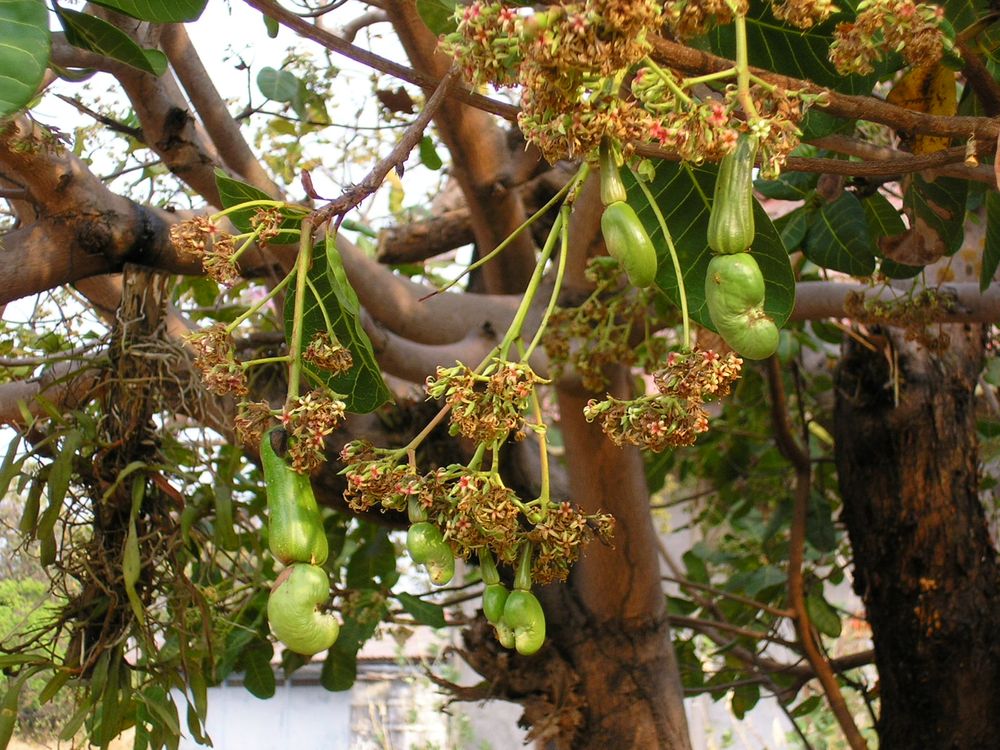
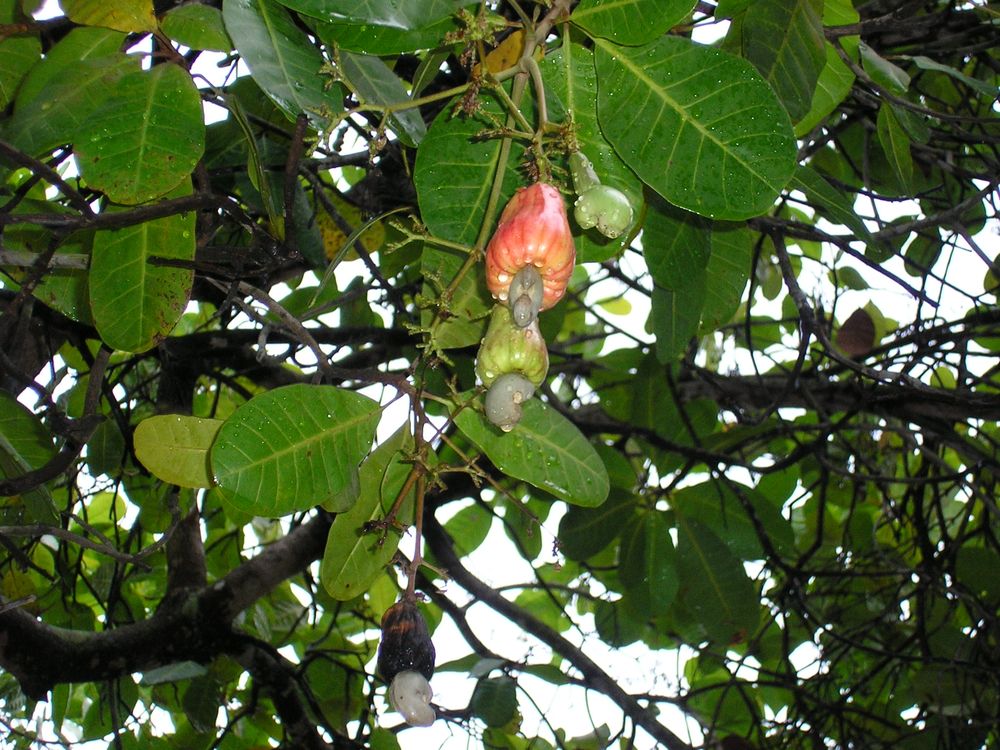
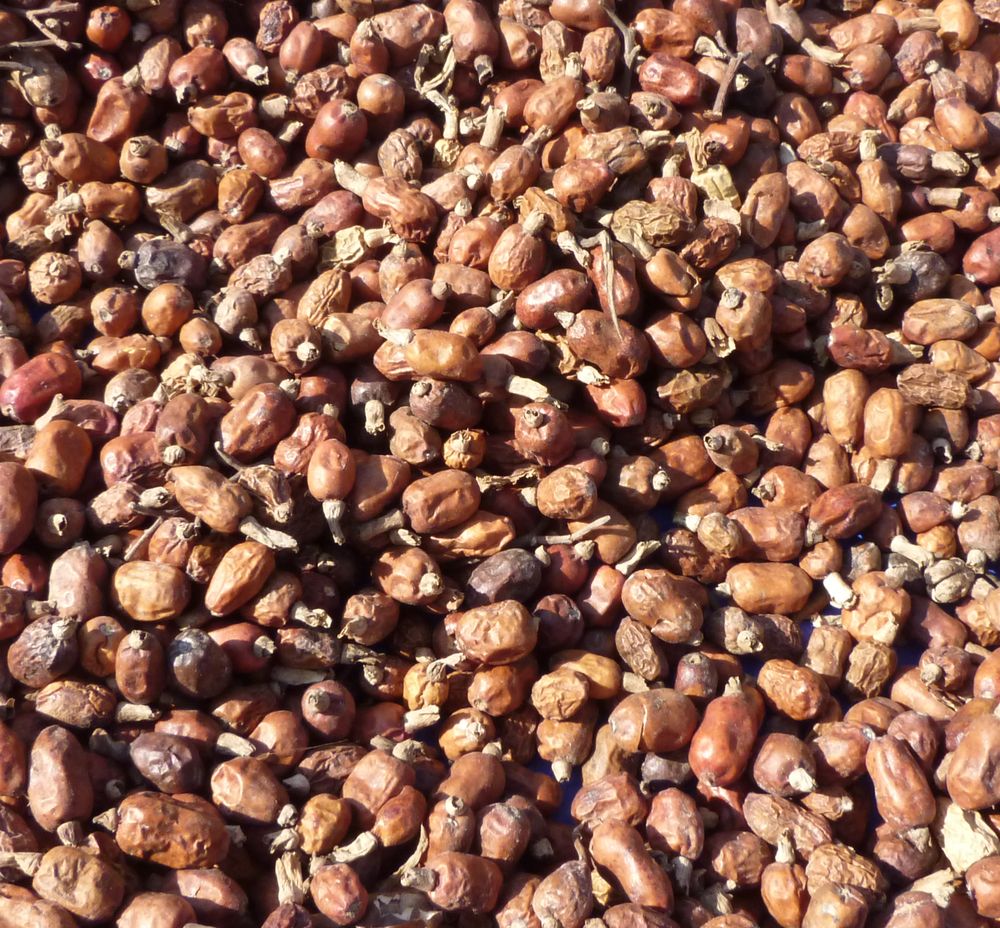
Everyone knows the cashew nut that delights our appetizers and pastries, but few know what the plant that produces it looks like; it is so amazing that the Lao people call it muang himapharn: “mango of paradise”. Its name, in French and in English, is “a travel term”, introduced into the language by missionaries, botanists and adventurers of all kinds, who traveled the world from the 16th century and brought back rare and exotic products. In this case, the word “cashew” is taken from the Amerindian tupi language of Brazil, where this plant is native; however, there is an etymological confusion, the word designating both a fruit and a tree, cashew and mahogany.
The cashew tree is not very remarkable, of medium size, its trunk is short, its leaves obovate, 10-20 cm long, its flowers small and white. Its “fruit” is fleshy in the shape of a small pear of a pretty color ranging from red to orange-yellow, called cashew apple; it is prolonged by the “nut” in the shape of a kidney. Botanically speaking it is this nut which is the fruit, its support being only a hypertrophied peduncle, a false fruit.
The cashew apple tree, which prefers dry and sandy soils, is grown in all tropical countries; in the Indochinese peninsula, it grows especially in Cambodia and in the south of Vietnam and Thailand.
Cashew apples are not found in markets in temperate countries because they do not keep well once picked. In Laos, as often, it is eaten with salt and pepper. Elsewhere it is eaten ripe and its more or less tangy taste is very refreshing, it is also particularly rich in vitamin C; it is also made into juices and jams.
Undoubtedly it is the nut that has the most uses. When the apple is withered or has been eaten, there remains the nut which is brought to the fire to eliminate the caustic principle contained in the envelope, it can then be broken and the kernel tasted after having stripped of its thin skin.
By pressure, an oil is extracted from the almond which has characteristics very similar to those of the sweet or bitter almond; it is used in food and in pharmacy.
From the incised bark of the cashew apple tree flows a sap used for the preparation of indelible ink and to dye fabrics black. The oldest trees give a gum which can make a good varnish for wood and which also has insecticidal properties.
The irritating liquid extracted from the fruit envelope, “cashew balm”, is used externally against warts, corns, cracks on the sole of the foot and formerly leprosy; internally it is a good vermifuge. The Institute of Traditional Medicine also recommends leaf decoctions to fight diabetes.
Tout le monde connaît la noix de cajou qui fait les délices de nos apéritifs et de nos pâtisseries, mais peu savent à quoi ressemble la plante qui la produit; elle est si étonnante que les Lao la nomment muang himapharn: « mangue du paradis ». Son nom, en français et en anglais, est « un terme de voyage », introduit dans la langue par les missionnaires, botanistes et aventuriers de toutes espèces, qui parcourent le monde à partir du XVIème siècle et en rapportent produits rares et exotiques. En l’occurrence le mot « cajou » est pris à la langue amérindienne tupi du Brésil, d’où est native cette plant; il y a cependant une confusion étymologique, le mot désignant à la fois un fruit et un arbre, le cajou et l’acajou.
L’arbre à cajou n’est pas très remarquable, de taille moyenne, son tronc est court, ses feuilles obovales, longues de 10- 20 cm, ses fleurs petites et blanches. Son « fruit » est charnu en forme de petite poire d’une jolie couleur allant du rouge au jaune orangé, appelé pomme de cajou; il est prolongé par la « noix » en forme de rein. Botaniquement parlant c’est cette noix qui est le fruit, son support n’étant qu’un pédoncule hypertrophié, un faux fruit.
Le pommier cajou qui préfère les terrains secs et sableux, est cultivé dans tous les pays tropicaux; dans la péninsule indochinoise, il pousse surtout au Cambodge et au sud du Vietnam et de la Thaïlande.
On ne trouve pas de pomme cajou sur les marchés des pays tempérés car elle se conserve très mal une fois cueillie. Au Laos, comme souvent, elle est mangée avec du sel et du piment. Ailleurs on la mange mûre et son goût plus ou moins acidulé est très rafraîchissant, elle est d’ailleurs particulièrement riche en vitamine C; on en fait aussi des jus et des confitures.
Mais c’est sans conteste la noix qui a le plus d’utilisations. Lorsque la pomme est flétrie ou qu’elle a été mangée il reste donc la noix que l’on porte au feu pour éliminer le principe caustique contenu dans l’enveloppe, on peut alors la casser et en déguster l’amande après l’avoir débarrassée de sa fine peau.
Par pression on extrait de l’amande une huile qui a des caractéristiques très voisines de celles de l’amande douce ou amère; on l’utilise dans l’alimentation et en pharmacie.
De l’écorce incisée du pommier cajou s’écoule une sève utilisée pour la préparation d’encre indélébile et pour teindre les tissus en noir. Les arbres les plus vieux donnent une gomme qui peut faire un bon vernis pour le bois et qui a en outre des propriétés insecticides.
Le liquide irritant extrait de l’enveloppe de fruit, « le baume de cajou », est utilisé, en usage externe, contre les verrues, les cors, les crevasses de la plante du pied et autrefois la lèpre; en usage interne c’est un bon vermifuge. L’Institut de médecine traditionnelle préconise également des décoctions de feuilles pour lutter contre le diabète.










Everyone knows the cashew nut that delights our appetizers and pastries, but few know what the plant that produces it looks like; it is so amazing that the Lao people call it muang himapharn: “mango of paradise”. Its name, in French and in English, is “a travel term”, introduced into the language by missionaries, botanists and adventurers of all kinds, who traveled the world from the 16th century and brought back rare and exotic products. In this case, the word “cashew” is taken from the Amerindian tupi language of Brazil, where this plant is native; however, there is an etymological confusion, the word designating both a fruit and a tree, cashew and mahogany.
The cashew tree is not very remarkable, of medium size, its trunk is short, its leaves obovate, 10-20 cm long, its flowers small and white. Its “fruit” is fleshy in the shape of a small pear of a pretty color ranging from red to orange-yellow, called cashew apple; it is prolonged by the “nut” in the shape of a kidney. Botanically speaking it is this nut which is the fruit, its support being only a hypertrophied peduncle, a false fruit.
The cashew apple tree, which prefers dry and sandy soils, is grown in all tropical countries; in the Indochinese peninsula, it grows especially in Cambodia and in the south of Vietnam and Thailand.
Cashew apples are not found in markets in temperate countries because they do not keep well once picked. In Laos, as often, it is eaten with salt and pepper. Elsewhere it is eaten ripe and its more or less tangy taste is very refreshing, it is also particularly rich in vitamin C; it is also made into juices and jams.
Undoubtedly it is the nut that has the most uses. When the apple is withered or has been eaten, there remains the nut which is brought to the fire to eliminate the caustic principle contained in the envelope, it can then be broken and the kernel tasted after having stripped of its thin skin.
By pressure, an oil is extracted from the almond which has characteristics very similar to those of the sweet or bitter almond; it is used in food and in pharmacy.
From the incised bark of the cashew apple tree flows a sap used for the preparation of indelible ink and to dye fabrics black. The oldest trees give a gum which can make a good varnish for wood and which also has insecticidal properties.
The irritating liquid extracted from the fruit envelope, “cashew balm”, is used externally against warts, corns, cracks on the sole of the foot and formerly leprosy; internally it is a good vermifuge. The Institute of Traditional Medicine also recommends leaf decoctions to fight diabetes.
Tout le monde connaît la noix de cajou qui fait les délices de nos apéritifs et de nos pâtisseries, mais peu savent à quoi ressemble la plante qui la produit; elle est si étonnante que les Lao la nomment muang himapharn: « mangue du paradis ». Son nom, en français et en anglais, est « un terme de voyage », introduit dans la langue par les missionnaires, botanistes et aventuriers de toutes espèces, qui parcourent le monde à partir du XVIème siècle et en rapportent produits rares et exotiques. En l’occurrence le mot « cajou » est pris à la langue amérindienne tupi du Brésil, d’où est native cette plant; il y a cependant une confusion étymologique, le mot désignant à la fois un fruit et un arbre, le cajou et l’acajou.
L’arbre à cajou n’est pas très remarquable, de taille moyenne, son tronc est court, ses feuilles obovales, longues de 10- 20 cm, ses fleurs petites et blanches. Son « fruit » est charnu en forme de petite poire d’une jolie couleur allant du rouge au jaune orangé, appelé pomme de cajou; il est prolongé par la « noix » en forme de rein. Botaniquement parlant c’est cette noix qui est le fruit, son support n’étant qu’un pédoncule hypertrophié, un faux fruit.
Le pommier cajou qui préfère les terrains secs et sableux, est cultivé dans tous les pays tropicaux; dans la péninsule indochinoise, il pousse surtout au Cambodge et au sud du Vietnam et de la Thaïlande.
On ne trouve pas de pomme cajou sur les marchés des pays tempérés car elle se conserve très mal une fois cueillie. Au Laos, comme souvent, elle est mangée avec du sel et du piment. Ailleurs on la mange mûre et son goût plus ou moins acidulé est très rafraîchissant, elle est d’ailleurs particulièrement riche en vitamine C; on en fait aussi des jus et des confitures.
Mais c’est sans conteste la noix qui a le plus d’utilisations. Lorsque la pomme est flétrie ou qu’elle a été mangée il reste donc la noix que l’on porte au feu pour éliminer le principe caustique contenu dans l’enveloppe, on peut alors la casser et en déguster l’amande après l’avoir débarrassée de sa fine peau.
Par pression on extrait de l’amande une huile qui a des caractéristiques très voisines de celles de l’amande douce ou amère; on l’utilise dans l’alimentation et en pharmacie.
De l’écorce incisée du pommier cajou s’écoule une sève utilisée pour la préparation d’encre indélébile et pour teindre les tissus en noir. Les arbres les plus vieux donnent une gomme qui peut faire un bon vernis pour le bois et qui a en outre des propriétés insecticides.
Le liquide irritant extrait de l’enveloppe de fruit, « le baume de cajou », est utilisé, en usage externe, contre les verrues, les cors, les crevasses de la plante du pied et autrefois la lèpre; en usage interne c’est un bon vermifuge. L’Institut de médecine traditionnelle préconise également des décoctions de feuilles pour lutter contre le diabète.


